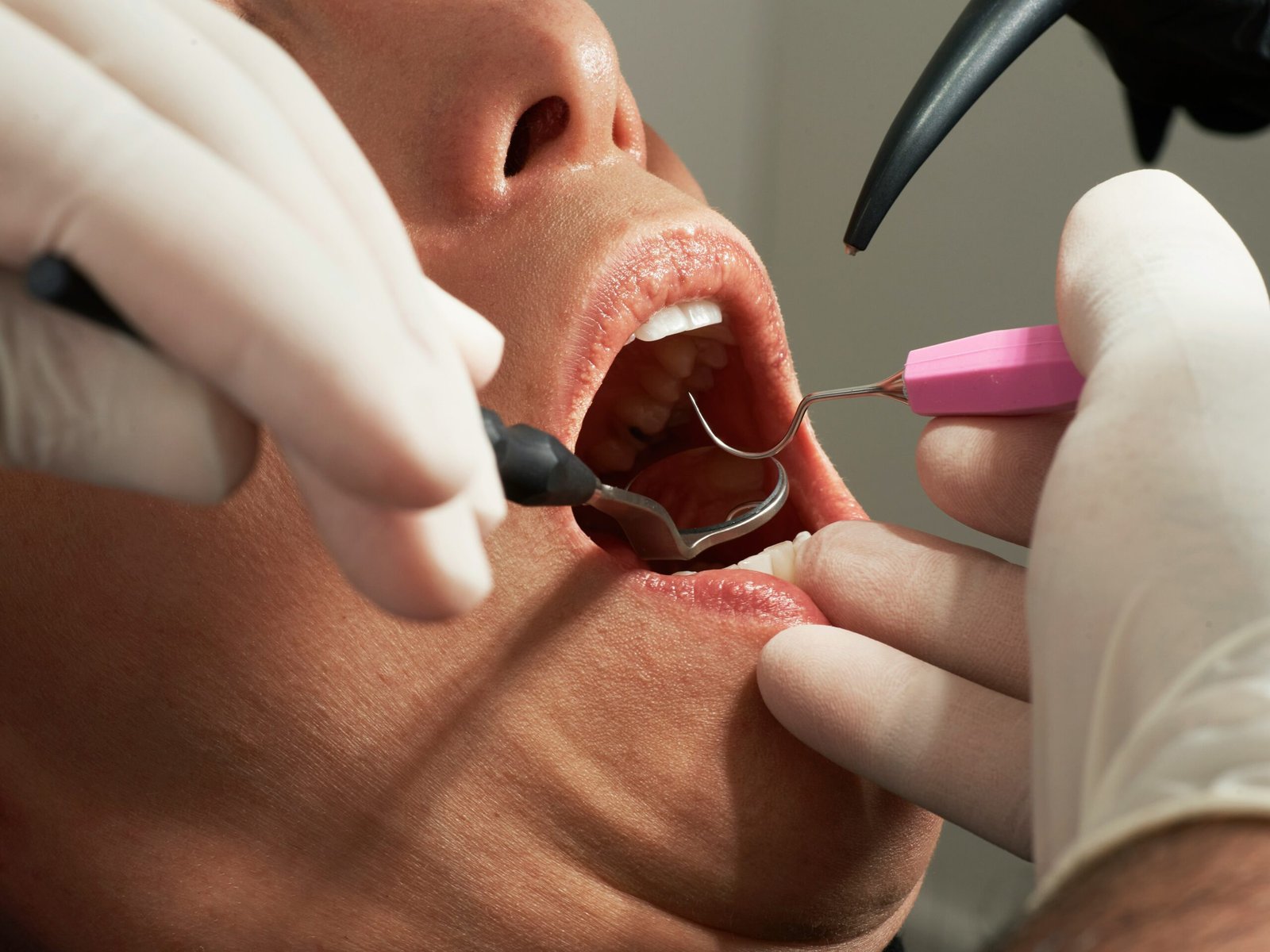Dental Implants vs. Dental Bridges
When people miss teeth, they often have to choose between dental implants or dental bridges. Both have their perks and quirks, so knowing the differences is good before deciding.
Understanding Tooth Replacement Options
Dental Implants: Think of dental implants as the strong, silent type. They’re titanium posts that get cozy in your jawbone, acting like a solid base for your new tooth. These implants are like the real deal—they look and feel like natural teeth. Plus, they’re tough against stains and bring back that comfy, functional smile.
Dental Bridges: Dental bridges are like a team effort. They fill the gap left by missing teeth by anchoring to the neighboring teeth, which often get crowned for extra support. Bridges can be made from stuff like porcelain, ceramic, or metal.
Factors to Consider
When picking between dental implants and bridges, here are some things to chew on:
Cost: Bridges are usually easier on the wallet upfront. An essential bridge might cost you around $500 per tooth, but fancier ones can go up to $1,200. Don’t forget the crowns, which can add another $500 to $2,500 per tooth. Conversely, implants are a bit pricier, running about $3,000 to $4,500 per tooth. Insurance might give bridges a thumbs-up more often than implants.
| Tooth Replacement Option | Cost per Tooth | Insurance Coverage |
|---|---|---|
| Dental Bridge | $500 – $1,200 (plus $500 – $2,500 for crowns) | More likely |
| Dental Implant | $3,000 – $4,500 | Less likely |
Longevity and Success Rates: Implants are like the marathon runners of tooth replacement, boasting a success rate of over 98% when done right. Bridges, while good, might need a pit stop for repairs or replacement down the road.
Aesthetics and Functionality: Implants win the beauty contest, offering a natural look and feel. They’re also stain-resistant and don’t mess with the teeth next door. Bridges look nice, too, but they might not match the comfort and function of implants.
Procedure and Recovery: Getting implants involves surgery and a longer healing time as the implant bonds with the jawbone. Bridges are more of a quick fix, needing less time and fewer dentist visits.
Bone Health: Implants are like a gym for your jawbone, keeping it healthy by encouraging bone growth. Bridges don’t offer this perk and might lead to bone loss over time.
For more details, check out our article on dental bridge vs implant.
By weighing these factors, people can determine whether dental implants or bridges are their best bet. Chatting with a dental pro for a tailored recommendation is always wise. For more on costs, see our articles on dental implant and dental bridge costs.
Dental Bridges Explained
Dental bridges are like the unsung heroes of the dental world, stepping in to fill the gaps left by missing teeth. They’re made up of two or more crowns on the teeth flanking the gap, with a false tooth or teeth, called pontics, nestled in between. These points can be crafted from gold, alloys, porcelain, or a mix. Knowing the ins and outs of different dental bridges can help you make a choice that suits your needs.
Types of Dental Bridges
Dental bridges come in a few flavors, each with its perks:
- Traditional Dental Bridges: The old reliable of dental bridges. They feature an artificial tooth or teeth held in place by crowns on either side. These bridges are great for replacing the visible part of missing teeth.
- Implant-Supported Bridges: These are the heavy-duty options anchored to dental implants that bond with the jawbone. They replace teeth from root to crown, offering more stability and helping to keep the jawbone healthy.
- Cantilever Bridges: These are the go-to when there’s only one neighboring tooth to latch onto. They’re not as standard and are usually used for front teeth with less bite pressure.
- Maryland Bridges: Also known as resin-bonded bridges, these are made from porcelain or porcelain fused to metal. They’re supported by a framework bonded to the back of the adjacent teeth.
Pros and Cons
Are you thinking about getting a dental bridge? Here’s the lowdown on the good and the not-so-good:
Pros
- Looks: Bridges can bring back your smile by filling in those pesky gaps.
- Functionality: They make chewing and talking easier, so you can enjoy your meals and conversations again.
- Speedy Process: Traditional bridges can be done quicker than implants.
- Budget-Friendly: They’re usually cheaper than implant-supported bridges.
Cons
- Tooth Alteration: Traditional bridges need the surrounding teeth shaved down for crowns, which can weaken them.
- Upkeep: Keeping them clean can be a chore, and there’s a risk of decay or damage to the crowned teeth.
- Durability: Unlike implant-supported cousins, traditional bridges might need fixing or replacing over time.
- Surgery Required: Implant-supported bridges involve surgery, which isn’t everyone’s cup of tea.
| Type of Bridge | Pros | Cons |
|---|---|---|
| Traditional | Quick, budget-friendly | Needs tooth alteration, upkeep |
| Implant-Supported | Stable, jawbone-friendly | Surgery needed, pricier |
| Cantilever | Handy for front teeth | Less common, limited use |
| Maryland | Less invasive | Not as tough, not for molars |
For more scoop on dental bridges and how they stack up against implants, check out our article on dental bridge vs implant. If you’re curious about the costs, our guide on dental bridge costs has you covered.
Dental Implants Unveiled
Dental implants are like the superheroes of tooth replacement, swooping in to save the day when teeth go missing. They come with many perks and different styles to fit your needs.
Types of Dental Implants
Consider dental implants as tiny titanium anchors that get cozy in your jawbone, ready to hold your new tooth tight. Here’s the lineup:
- Endosteal Implants: These are the go-to implants you’ll see most often. They dive right into the jawbone and can support one or more fake teeth.
- Subperiosteal Implants: These guys hang out under the gum but sit on the jawbone. Perfect for folks whose jawbone isn’t up for a bone-building makeover.
- Zygomatic Implants: The rarest of the bunch, these implants skip the jawbone and head straight for the cheekbone. They’re the choice when the jawbone’s not playing ball.
Benefits and Considerations
Dental implants have a leg up on other tooth replacements like bridges. Here’s why they’re worth a look:
Benefits:
- Longevity: These implants are built to last. Treat them right, and they’ll last a long time.
- Natural Feel and Appearance: They look and act like the real deal. Plus, they’re tougher against stains than natural teeth, bringing back your smile’s comfort and style (VCCID).
- Jawbone Preservation: Implants keep your jawbone strong, stopping bone loss when teeth go AWOL. The titanium bonds with the jawbone, giving your new teeth a solid base without slipping or bone damage (Mayo Clinic).
- Improved Oral Health: Unlike bridges, implants don’t mess with the neighboring teeth, keeping more of your natural smile intact.
Considerations:
- Surgical Procedure: Getting implants is a journey. It starts with placing the implant and waiting for it to heal before adding the new tooth, which can take a few months.
- Cost: Implants can be pricier than other options. Check out the cost of dental implants and see what insurance coverage might help.
- Health Requirements: Not everyone can get implants. They work only on strong bones and healthy gums. A thorough check-up will tell you if you’re a good fit (Mayo Clinic).
| Type of Implant | Placement | Suitable For |
|---|---|---|
| Endosteal | Directly into the jawbone | Most common, suitable for most patients |
| Subperiosteal | Under the gum, above the jawbone | Patients with insufficient jawbone |
| Zygomatic | In the cheekbone | Patients with severe jawbone loss |
For more scoop on how dental bridges stack up against implants, check out our article on dental bridge vs implant. If you’re thinking about getting implants, chat with a dental pro to find the best fit for you.
Longevity and Success Rates
When you’re thinking about swapping out those missing teeth, it’s good to know how long dental bridges and implants will stick around and how often they do the job right. Let’s break down how long dental bridges last and how successful dental implants are.
Lifespan of Dental Bridges
Dental bridges are like trusty sidekicks for filling in those gaps. With the right care, they can last about 10 to 15 years (Cleveland Clinic). How long they last depends on how well you treat your teeth, what they’re made of, and where they sit in your mouth.
| Dental Bridge Type | Average Lifespan |
|---|---|
| Traditional Bridge | 10 – 15 years |
| Cantilever Bridge | 10 – 15 years |
| Maryland Bridge | 10 – 15 years |
Want to know more about the different types of dental bridges? Check out our article on dental bridge.
Success Rate of Dental Implants
Dental implants are like the permanent VIPs of tooth replacement, boasting a 90 to 95 percent success rate over a decade (Healthline). Success can vary based on the implant type and your overall health.
| Dental Implant Type | Success Rate (10 years) |
|---|---|
| Endosteal Implants | 90 – 95% |
| Mini Dental Implants (MDIs) | 90 – 95% |
If the treatment is planned with solid scientific and clinical know-how, dental implants can have a long-term success rate of over 98% (VCCID). With the proper care, they can last a lifetime, making them a tough and trusty choice for replacing teeth.
For more scoop on dental implants, visit our article on dental implants.
Knowing how long dental bridges and implants last and how often they succeed can help you pick the best option for your smile. For advice tailored to you, chat with a dental pro who can check out your situation and give you the lowdown.
Cost Analysis
Knowing what you’re getting into financially is essential when thinking about replacing missing teeth. Let’s summarize your spending on dental bridges and implants and how insurance might help.
Financial Considerations
Dental bridges and implants have different price tags. Bridges are usually the cheaper option at first but remember to consider what you’ll pay down the road.
| Tooth Replacement Option | Cost per Tooth |
|---|---|
| Dental Bridge (low-end) | $500 |
| Dental Bridge (high-end) | $1,200 |
| Dental Crown (extra) | $500 – $2,500 |
| Dental Implant | $3,000 – $4,500 |
Numbers from Healthline
Bridges can run you anywhere from $500 to $1,200 per tooth. But wait, there’s more! You might need a crown to hold that bridge in place, which could add another $500 to $2,500 per tooth (Healthline).
Conversely, implants are a bit pricier, usually between $3,000 and $4,500 per tooth (Healthline). They might cost more but last long, restoring your smile and chewing power (VCCID).
Want more on implant costs? Check out our article on dental implants cost.
Insurance Coverage
Insurance can be a mixed bag for covering bridges and implants. Bridges are more likely to get the green light from insurance since they’re a common fix for missing teeth. But how much they cover can depend on your plan.
| Tooth Replacement Option | Insurance Coverage Likelihood |
|---|---|
| Dental Bridge | High |
| Dental Implant | Low |
Implants, though, might not be as lucky. Many insurance plans see them as a cosmetic choice, so they might not be covered. Chatting with your insurance folks to see what they’ll pay for and what you’ll need to cover yourself is a good idea.
If you’re leaning towards implants, look into financing or discount plans to help with the cost. Some dental offices even offer payment plans to spread out the expense.
Curious about the differences between bridges and implants? Visit our article on dental bridge vs implant.
By getting a handle on the costs and insurance for bridges and implants, you can make a choice that fits your wallet and your smile. For advice tailored to you, have a chat with your dentist to figure out the best path for your dental health.
Decision Making Process
Picking between a dental implant bridge and other tooth replacement options can feel like a big decision. This section is here to help you through the steps so you can make a choice that suits you best.
Consultation and Evaluation
First things first, you gotta book a chat with a dentist. During this visit, the dentist will check out your oral health, talk about your dental past, and get a feel for what you need and want. Here’s what usually happens:
- Oral Check-Up: The dentist will examine your mouth, checking your teeth, gums, and jawbone.
- X-rays and Pictures: They might take X-rays or other images to assess your jawbone and spot any hidden issues.
- Health History Chat: They’ll review your medical history, including any ongoing health issues or medications, to ensure you’re a good fit for implants or bridges.
This deep dive helps the dentist devise the best game plan for you. For more details, check out our page on dental implants.
Personalized Recommendations
After the consultation, the dentist will dish out some advice tailored just for you. They’ll consider a bunch of things, like:
- Oral Health: How your teeth, gums, and jawbone are doing will play a big role in deciding if implants or bridges are right for you.
- Looks and Function: The decision will be influenced by what you want in terms of how it looks and works.
- Money Matters: The cost is a biggie. Implants might cost more upfront but can be worth it in the long run. For a cost breakdown, check out our pages on dental implants cost and dental bridge cost.
- Lifestyle: How you live and your daily habits might sway the choice between implants and bridges. Implants are more of a set-it-and-forget-it deal, while bridges might need more TLC.
| Factor | Dental Implants | Dental Bridges |
|---|---|---|
| Longevity | 20+ years | 5-15 years |
| Success Rate | Over 98% (VCCID) | Varies |
| Cost | Higher initial cost | Lower initial cost |
| Maintenance | Minimal | Regular adjustments |
The dentist will lay out the pros and cons of each option, helping you make a smart choice. For more on how these options stack up, check out our article on dental bridge vs implant.
By following this process, you can pick the tooth replacement that fits you best, keeping your smile bright and healthy. For more tips, explore our resources on 8 signs that you need dental implants and all on 4 dental implants price.











